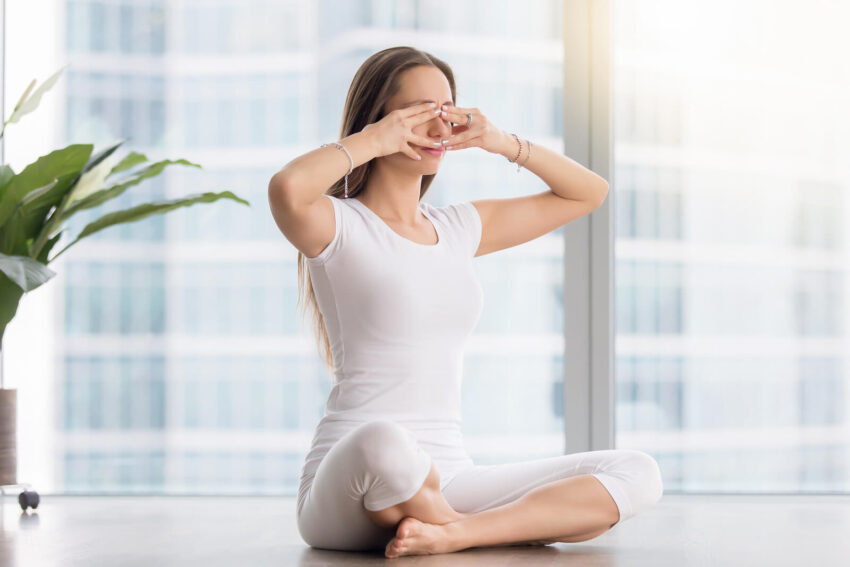In our modern, tech-driven world, where screens dominate our daily lives, maintaining good eyesight has become increasingly challenging. The constant exposure to digital devices, coupled with a sedentary lifestyle, can lead to eye strain and various vision-related issues. However, a holistic approach to eye care involves not only minimizing screen time but also incorporating yoga into our routine. Yoga, an ancient practice known for its myriad health benefits, offers a set of specific asanas (poses) that can contribute significantly to better eyesight. Let’s delve into the top 10 yoga tips and asanas that can help improve and maintain optimal eye health.
10 Yoga Tips Asanas For Better Eyesight
Palming (Hasta Mudra)
Begin your eye yoga routine with palming, a simple yet effective technique. Rub your palms together briskly to generate heat, then gently cup them over your closed eyes without applying pressure. Feel the warmth penetrating your eyes, relieving tension and promoting relaxation. Palming is an excellent practice to soothe tired eyes and improve focus.

Blinking (Netra Abhyas)
While it may sound too basic, conscious blinking is crucial for lubricating the eyes and preventing dryness. Sit comfortably, close your eyes, and blink rapidly for about 30 seconds. Follow this with a few moments of closed eyes to let them rest. This practice enhances tear production, keeping your eyes moist and preventing irritation.
Eye Rotation (Gyana Naman)
Eye rotation is a gentle exercise that helps increase the flexibility of the eye muscles. Sit in a comfortable position and slowly rotate your eyes clockwise, then counterclockwise. Repeat this for a few rounds, gradually increasing the duration. This asana improves blood circulation to the eyes, promoting better vision.
Upward Gaze (Shanmukhi Mudra)
Sit with your spine straight and focus your gaze on a point slightly above eye level. This asana helps strengthen the muscles around the eyes and improves concentration. Regular practice of the upward gaze can also alleviate symptoms of eye fatigue.
Palming with Visualizations
Combine palming with visualization techniques for a more profound impact on your eyesight. After palming, visualize a soothing image, such as a serene landscape or a favorite color. This not only relaxes the eye muscles but also engages the mind positively, reducing overall stress.
Trataka (Concentration)
Trataka, or steady gazing, involves concentrating on a single point, such as a candle flame or a small object. This asana enhances focus and stimulates the optic nerves. Practice trataka regularly to develop better eye-mind coordination and improve visual acuity.

Downward Gaze (Adho Mukha Shvanasana)
This classic yoga pose involves an inversion that increases blood flow to the head, including the eyes. Perform downward dog pose with your head hanging freely towards the ground. This helps relieve eye strain and may contribute to a reduction in intraocular pressure.
Child’s Pose (Balasana)
Child’s pose is a restorative asana that promotes relaxation and reduces stress. While in this pose, focus on your breath and let go of any tension around your eyes and forehead. Child’s pose helps release strain in the eye muscles and encourages a state of calmness.
Eye Palming with Aromatherapy
Enhance the benefits of palming by incorporating aromatherapy. Before palming, apply a drop of soothing essential oil, such as lavender or chamomile, to your palms. Inhale the calming aroma as you cover your closed eyes, adding an extra layer of relaxation to the exercise.
Yoga Nidra for Deep Relaxation
Yoga Nidra, also known as yogic sleep, is a guided meditation that induces a state of deep relaxation. Practice a yoga nidra session specifically focused on eye relaxation. This can help alleviate stress, promote better sleep, and contribute to overall eye health.
Conclusion
Incorporating these yoga tips and asanas into your daily routine can be a transformative step toward maintaining and improving your eyesight. As with any exercise regimen, consistency is key, so make these practices a part of your holistic approach to eye care. Remember, while these yoga asanas can contribute to better eyesight, it’s essential to complement them with a balanced lifestyle, including a nutritious diet and regular eye check-ups. Embrace the ancient wisdom of yoga, and gift your eyes the care and attention they deserve in our fast-paced digital age.
Read More:- Calendula Flower: A Flowing Plant Aiding In Restoring Skin Health!
Read More:-Exploring the Multifaceted World of Tea: Unearthing Its Unexpected Effects


